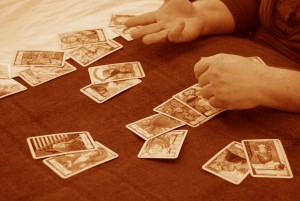Tarot is a divination discipline which helps the “querent” (or client – the one asking the questions) and reader to tap into the collective unconscious and reflects the potentiality of the individual in a particular time-frame – right now.

Laying out the cards for a tarot reading
Tarot cards came to Europe in the 13th century, when they were introduced into Italy probably via Persia and Egypt. The suits resemble a normal pack of playing cards with the addition of the ‘Major Arcana’ – picture cards bearing symbols of important archetypes, such as “Love” and “Death”.
Tarot can throw light on specific issues, superceding general indications from a birth-chart, and is also very useful in cases when no reliable birth time is known. When Jyotish can tell you a new job is coming your way, tarot may help clarify which job offer to accept.
The card-reader asks the querent to focus on their question while they shuffle and then select cards. There are various card layouts possible; the modified Celtic Cross is one which Pam often uses. Divinatory meanings of tarot cards are related to Kabbala and Alchemy traditions, although it takes an experienced card reader to apply them to the querent’s issues.